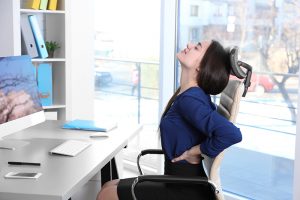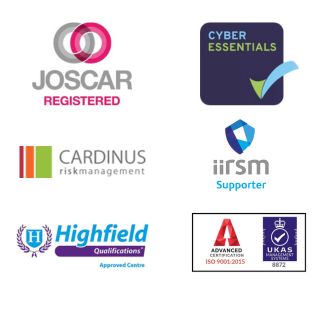DSE Assessments: How often should they be completed?

Businesses and employees are working more flexibly that ever. In the wake of the global COVID pandemic it is now commonplace for employees to work both at the office and at home in any given week, or to have even opted to be entirely remote working.
With this, comes an increasing need for both employers and employees to be aware of the risks of prolonged use of Display Screen Equipment (DSE) and have the knowledge and ability to carry out a DSE assessment of their working environment and get help to rectify any issues identified wherever they are located.
In this blog, we look at how frequently a DSE assessment should be carried out and some of the common triggers for reassessment.
Minimum Programme of Regular Re-assessment
It’s inevitable that bodies will change, habits will develop, chairs will deteriorate, and monitors will be moved around. It’s for these naturally occurring reasons that a regular re-assessment programme should be put in place so that all employees complete a DSE check on a regular basis.
At Sureteam, we recommend that as a minimum a new DSE Assessment is undertaken for every employee, every 2 years. We also promote the ongoing education of employees so that they fully understand the risks, good practice and steps they can take to make their own adjustments to their seating positions and working habits outside of these more formal reviews.
In addition to regular assessments, there are a number of specific situations that should trigger an earlier DSE review and some of these are highlighted below.
New and Returning Employees
In the past, DSE Assessments have most likely been carried out for a new employee as part of their induction process. It would have been a natural part of their first week in the office along with meeting different department colleagues and a tour of the building.
However, with more new employees working only partly in the office, perhaps hot desking or working fully remote, these formal induction periods are more disjointed or even take place online, and so it’s important to ensure that a DSE assessment and training continue to be included in any induction programme.
The same is true for returning colleagues. Whether they are returning from maternity/paternity leave or from a period of prolonged illness, it is important that a DSE assessment is completed, even if they are returning to the same desk.
Change of Location or Workstation
Whether it’s simply changing desks or moving to a completely new office (with or without the same desk), if an employee is working at a different location, then a new DSE Assessment should be conducted.
It’s a common misconception that DSE audits are just focused on the user and the equipment they use, but they should also incorporate an evaluation of their environment including lighting, noise levels, air quality and screen glare.
These are all things that could potentially change when an individual moves location even if it is only just metres away from their old desk.
Change in Equipment
If a user has a new piece of kit whether it’s a new chair, desk or computer then a new DSE Assessment is required.
A common scenario we come across is where a business conducts a DSE Assessment, identifies an issue, replaces some furniture and then doesn’t revisit the assessment to ensure the new furniture is fit for purpose and has addressed the issue identified.
So, whether it is a complete office refurbishment or simply replacing a couple of old chairs, if the employee has a new piece of equipment a DSE Assessment is required.
Change in Role
Don’t forget too, those that have changed their role within the organisation which results in them working with display screen equipment for longer hours. For example, those that may have spent hours supervising in a warehouse but who are now on the management team sitting behind a desk for more hours, need to be aware of the increased DSE risks so they can identify and correct any issues.
Change in Working Patterns
Clearly as a result of the pandemic, the biggest change for many businesses in the area of DSE risks is that employee working patterns have changed significantly.
A good number of workers are no longer in the office 100% of the time. Many now work a significant number of days a week from home, others have to hot desk as a result of organisations closing offices during COVID, whilst others have opted to be fully remote going forward which could be in their home or in a location that suits them such as a library or coffee shop.
The challenge now facing employers is one of management and oversight, when their teams are no longer working from a central office. How do they empower workers to understand the risks involved and then carry out their own DSE assessments in all of the locations they work, as well as ensure they have taken place and that any issues identified are rectified?
This is where a combined online DSE training and assessment course is especially useful for both managers in ensuring their health and safety responsibilities have been carried out, as well as empowering employees to identify areas that are causing discomfort or worse, pain and how to rectify it.
There are a lot of other issues besides DSE assessments that employers need to think about with a fully or partially remote workforce and you can read more in our blog Agile working – the new normal – what employers need to think about.
The Risks of Not Doing Regular DSE Assessments?
Being proactive about DSE Assessments and training and encouraging your staff to take responsibility and raise concerns is key to ensuring any issues are raised quickly and pain and discomfort avoided.
If a member of the team is experiencing pain or discomfort that could be linked to working with display screen equipment, obvious ones being back pain, neck pain or eye strain, a DSE Assessment should be carried out to analyse whether the pain is caused by their working position and appropriate action taken.
Equally, if the individual has any significant changes to their personal health that could affect the use of DSE at work, an assessment should be carried out to take into considerations their specific circumstances as part of wider occupational health support.
This image is a useful reminder for the correct sitting posture:
Other DSE Resources
If you want to train up someone in your organisation to be competent to carry out DSE assessments then take a look at our DSE Assessor E-Learning Course.
Our Resources page also has links to some helpful documents by the HSE including:
Home working – your health and safety – a guide for employees
Good Posture when using display screen equipment
Display Screen Equipment Checklist
Need Some Help from Sureteam?
There are very few employees who will not use some form of display screen equipment in their role so a robust DSE assessment policy is required for most businesses.
Our professional team have extensive experience in conducting DSE Assessments and our new Healthy Working Program E-Learning Suite provides businesses with proactive DSE support that can be tailored to their business.
To find out more, give one of our team a call on 01666 503686 or click on the button below to fill out our contact form.








